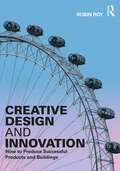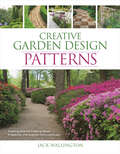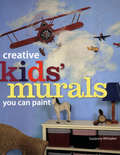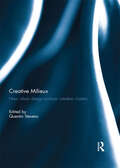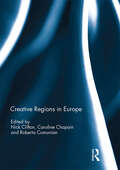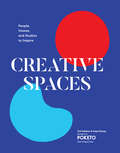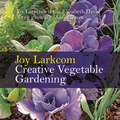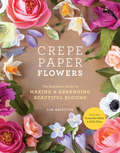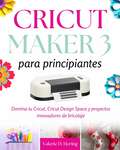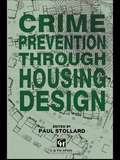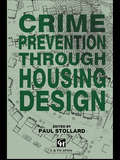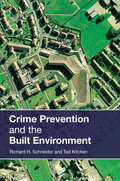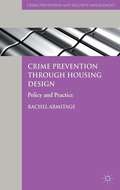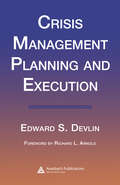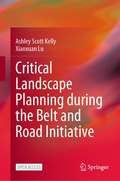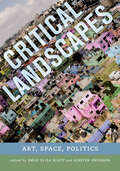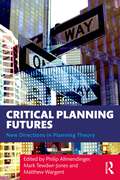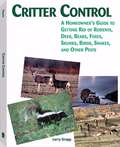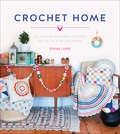- Table View
- List View
Creative Design and Innovation: How to Produce Successful Products and Buildings
by Robin RoyUsing many real-world examples and cases, this book identifies key factors and processes that have contributed to the creation of successful new products, buildings, and innovations, or resulted in some failures. Such factors include the creativity of individuals and groups, their sources of inspiration, the processes of creative design and innovation, and the characteristics of the products, buildings, and innovations themselves. Much has been written about creativity and innovation, but what helps to foster creativity, enable creative ideas to be translated into practical designs, and ensure those new products or buildings succeed as innovations on the market or in use? This book discusses these elements through the author’s origination and analysis of examples and case studies ranging from the revolutionary innovation of the smartphone, through radical innovations in domestic appliances and sustainable housing, to creative designs of contemporary jewellery. The broad range of examples and cases include product and fashion design, filmmaking and fine art, as well as industrial design, engineering, and architecture, offering lessons for creatives, designers, and innovators from many subject backgrounds. Analysis of the different factors, successes, and failures are presented in text boxes throughout the book to allow readers to easily understand the key lessons from each example or case, with numerous colour visuals, diagrams, and charts for illustration. This book is a must-read for a broad audience interested in creativity, design, and innovation, including practitioners in design, engineering, architecture, and product management, and students and instructors of those subjects.
Creative Garden Design: Inspiring Ideas for Creating Mood, Proportion, and Scale for Every Landscape
by Jack WallingtonCreative Garden Design: Patterns is a unique and practical reference for creating mood, proportion and scale in the garden. Its more than 500 photographs reveal the hidden patterns in plants, gardens and the wider landscape to inspire plans for gardens of all sizes and illustrate how to appreciate the styles of design in larger gardens andparks.Explore the influences of pattern in design and thepeople who made them and gain a greater understanding of the roles of color, texture, shape and perspective in the garden.Each chapter explores a different theme of garden pattern, including:• Plants with Pattern: Leaf Shape and Texture• Patterns within Layouts: Symmetrical and Formal• Patterns with Plants: Borders and Bedding• Patterns in Landscape: Paving and Walls• Water Patterns: Pools and StreamsAdditional features include profiles of patterns ingarden design history from abstract to Islamic gardens.A complete visual delight, Creative Garden Design:Patterns is a classic work that deserves pride of place on every garden designer&’s bookshelf.
Creative Home Decorating
by Hazel Kory Rockow Julius RockowInterest in home decoration is at a higher pitch today than ever before. Modern techniques of production have made home furnishings available to all persons and at all income levels. Home decoration is a creative activity. As such, it is guided by principles and aesthetic values common to all the creative arts. Trial and error is uneconomical of money, time and effort and, all too often, never transcends error. For this reason, the authors have emphasized principles throughout the book, as well as their practical application.
Creative Kids' Murals You Can Paint
by Suzanne WhitakerPaint Imaginative Murals Especially for Kids!Transform an ordinary room into a playground of imagination. Creative Kids' Murals You Can Paint blends inspiration with instruction so you can create the perfect mural for every special child you know.More than 50 whimsical wall paintings by author and children's muralist, Suzanne Whitaker, offer you a range of unique ideas, themes and color combinations, complete with 32 step-by-step demonstrations that make these murals easy and fun to recreate on your own walls. All the guidance you need is in this book, including:Start-to-finish steps for painting kids' favorites like a castle, Mother Goose characters, sports paraphernalia, bunnies, dog and cat, letters, numbers and much moreClear instruction for choosing materials, performing basic techniques, preparing surfaces, selecting colors and creating customized compositionsSeveral theme-based galleries of additional designs for extra inspirationYou can paint murals exactly as they're shown or use them as a jumping off point to design your own. These step-by-step demos allow you to mix and match mural components to suit you and your child's preferences.Wow your family and friends! With this guide, you really can paint creative kids' murals.
Creative Milieux: How Urban Design Nurtures Creative Clusters
by Quentin StevensThe so-called ‘creative industries’ are increasingly being presented as an important tool of urban regeneration and economic development. Until now, research on the clustering of such activities has been limited to economics, geography and urban policy. This book is the first to gather together emerging research in urban design and spatial planning that explores what characteristics of the built form of cities support the distinctive activity patterns of various creative industries, and how and why they cluster together at a range of local scales. The book offers detailed case studies and comparative analyses of creative city neighbourhoods on five continents. Contributions examine urban forms, building types, and other qualities of place that attract and retain creative workers and foster creative production, outlining a range of methodologies for studying them. Taken altogether, Creative Milieux offers new insights for urban design practice, and for its role in wider urban policy. This book was originally published as a special issue of the Journal of Urban Design.
Creative Regions in Europe
by Caroline Chapain Roberta Comunian Nick CliftonCreative and cultural industries, broadly defined, are now considered by many policy makers across Europe at the heart of their national innovation and economic development agenda. Similarly, many European cities and regions have adopted policies to support and develop these industries and their local support infrastructures. However this policy-making agenda implicitly incorporates (and indeed often conflates) elements of cultural and creative industries, the creative class and so on, which are typically employed without due consideration of context. Thus a better understanding is required. To this end, this book features eight research papers, split evenly with regard to geographical focus between the UK and continental Europe (the latter covering Spain, Germany, France, Luxemburg and Belgium individually and in combination). There is also a similar division in terms of those focusing primarily on the policy level (the chapters of Clifton and Macaulay, Mould and Comunian, Pareja-Eastaway and Pradel i Miquel, Perrin) and those of the individual creative actor (the chapters of Alfken et al, Bennett et al, Wedemeier and Brown). This book was previously published as a special issue of European Planning Studies.
Creative Spaces: People, Homes, and Studios to Inspire
by Angie Myung Ted VakadanThis debut book from acclaimed Los Angeles lifestyle brand Poketo proves creativity can be sparked anywhere. From a colorful desk in a tiny closet to expansive homes, Creative Spaces explores the lives, homes, and studios of 23 artistic entrepreneurs, authors, and designers through a collection of inspired interiors from across the country that brings art into the everyday. With stunning photography, intimate profiles, and unexpected takeaways, the book showcases an eclectic mix of creatives, including artist Adam J. Kurtz, ceramicist Helen Levi, and DJ Chris Manak, among others. Fusing lifestyle with interior design, this peek into the spaces and lives of creative professionals will motivate dreamers and thinkers to become doers and makers.
Creative Vegetable Gardening
by Joy LarkcomJoy Larkcom believes passionately that a vegetable garden, whatever its size, can be as beautiful as a conventional garden of flowers and shrubs. In Creative Vegetable Gardening she shows how the principles of good design can be applied to a kitchen plot and how to use the vibrant textures, colours, and forms of vegetables, herbs and fruit to create glorious effects and intriguing patterns without jeopardizing their productivity. Inspirational colour photographs of potagers and kitchen plots capture the essence of the creative approach to vegetable growing. Techniques are described in clear stages and illustrated with full-colour step-by-step artworks, while an A-Z directory includes more than 150 edible plants with key facts on their cultivation, supplemented with ideas on how to grow them to maximum ornamental effect. Beautifully illustrated, intricate plans of five types of potager - formal, informal, small, urban and winter - add to the wealth of inspirational information.
Creative Vegetable Gardening: Accenting Your Vegetables With Flowers
by Joy LarkcomJoy Larkcom believes passionately that a vegetable garden, whatever its size, can be as beautiful as a conventional garden of flowers and shrubs. In Creative Vegetable Gardening she shows how the principles of good design can be applied to a kitchen plot and how to use the vibrant textures, colours, and forms of vegetables, herbs and fruit to create glorious effects and intriguing patterns without jeopardizing their productivity. Inspirational colour photographs of potagers and kitchen plots capture the essence of the creative approach to vegetable growing. Techniques are described in clear stages and illustrated with full-colour step-by-step artworks, while an A-Z directory includes more than 150 edible plants with key facts on their cultivation, supplemented with ideas on how to grow them to maximum ornamental effect. Beautifully illustrated, intricate plans of five types of potager - formal, informal, small, urban and winter - add to the wealth of inspirational information.
Creative Wood Letters: 35 Simple Craft Projects for Decorating Your Home
by Krista Aasen<p>Krista Aasen of The Happy Housie blog presents a collection of 35 creative projects that can brighten up the walls of any house. <p>Decorating wood letters is a fun and simple project for the home, from a child's name in a bedroom to an uplifting message above the mantel. But how do you achieve the pin-worthy results of the stylists you see online? Enter Krista Aasen of The Happy Housie blog, whose crafting experiments with wood letters have been shared hundreds of thousands of times. <p>In Creative Wood Letters, Aasen reveals unique ideas and techniques to craft beautifully decorated letters inspired by everything from nature to art using maps, vintage book pages, photo transfer, paper flowers, washi tape, succulents, driftwood, metallic paints, lights, and more. With a wide variety of styles from rustic and beachy to cute and sparkly, this book's wood letters are perfect for gracing the walls, shelves, and nooks of kitchens, bedrooms, and beyond.</p>
Crepe Paper Flowers: The Beginner's Guide to Making and Arranging Beautiful Blooms
by Lia GriffithWith 30 projects and an introduction to both crafting paper flowers and working with crepe paper, this book is full of inspiration and expert advice for beginners. If you have a Cricut Maker, you can download the templates to your machine so you can enjoy your own homemade bouquets in no time.Crepe paper is the best material for creating paper flowers, especially for beginners. It's forgiving and malleable--easy to cut, bend, curl, and shape into peony petals, daffodil trumpets, chrysanthemum blooms, and more. And if you have a Cricut Maker, you can easily cut out the shapes from templates you download for free on Lia Griffith's website using a code. Then, follow instructions for crafting the flowers to arrange and display in vases and pots and as bouquets and wreaths.
Crescita & Coltivazione della Marijuana
by Hiddenstuff EntertainmentIl manuale definitivo e passo a passo per far crescere e coltivare la marijuana. Impara come far crescere la cannabis con passi facili da seguire dall'inizio alla fine. Impara ed inizia a far crescere in poche ore. Istruzioni semplici e facili da seguire. Utilizzando le strategie di crescita più efficaci puoi far crescere le tue piante come fanno i professionisti. Qui i contentuti: -Progetta la tua area per la coltivazione -Illuminazione -Aerazione -Come monitorare la crescita delle piante -Tipologie di ambienti per la crescita -Contenitori -Nutrienti -Innaffiare le piante Risparmia tempo e denaro utilizzando questo manuale definitivo. --> Vai all'inizio della pagina e clicca su aggiungi al carrello per comprarlo immediatamente Disclaimer: This author and or rights owner(s) make no claims, promises, or guarantees about the accuracy, completeness, or adequacy of the contents of this book, and expressly disclaims liability for errors and omissions in the contents within. This product is for reference use only.
Cricut Maker 3 für Anfänger: Meistern Sie Ihren Cricut, Cricut Design Space und innovative DIY-Projekte
by Valerie D. HeringWillkommen in der wunderschönen Welt des Cricut Maker! Dieser Leitfaden wurde zusammengestellt, um Ihnen dabei zu helfen, sich in der Bastelwelt von Cricut und den zahlreichen und faszinierenden Funktionen des Cricut-Geräts zurechtzufinden, damit Sie im Handumdrehen mit der Umsetzung einzigartiger DIY-Projekte beginnen können! Sie waren bestimmt auf der Suche nach einem Buch, das all Ihren Bastelbedürfnissen gerecht wird; Sie sind an der richtigen Stelle. Dieses Handbuch zeigt Ihnen, wie Sie Ihre Cricut-Maschine einrichten, mit Holz, Vinyl, Leder, Papier usw. arbeiten. Das Zusammenstellen dieser genialen Designs kann Ihre Fähigkeiten oft an die Grenzen bringen, wenn Ihr Schneidegerät nicht leicht zu verstehen ist. Verzweifeln Sie nicht, denn dieses Buch deckt alle Aspekte ab und bietet Ihnen umfassende Lektionen zur richtigen und einfachen Verwendung Ihres Cricut Makers. Jeder Abschnitt dieses Buches wurde speziell für Sie zusammengestellt, um Ihnen dabei zu helfen, praktische Erfahrungen zu sammeln und sich mit Ihrem neuen Gerät vertraut zu machen Cricut Maker 3. Sie werden intelligente Möglichkeiten entdecken, Funktionen wie den Cricut Design Space, benutzerdefinierte Materialeinstellungen, die Verwendung des besten Zubehörs für jedes Projekt und vieles mehr zu nutzen. Wenn Sie den Cricut Maker mit dem Cricut Explore Air oder Cricut Joy vergleichen, werden Sie feststellen, dass er leistungsstärker und hinsichtlich der Steuerung und anderer Funktionen etwas fortschrittlicher ist. Daher wurde der Fokus auf die kleinsten Details gelegt, um sicherzustellen, dass sowohl Neulinge als auch erfahrene Leute so schnell wie möglich das Beste herausholen können. Hier finden Sie eine Zusammenfassung dessen, was Sie von diesem Buch erwarten; - Einrichten Ihres Cricut Maker 3 - Machen Sie sich mit dem Gerät vertraut - Spielen im Design Space - Ve
Cricut Maker 3 para principiantes: Domina tu Cricut, Cricut Design Space y proyectos innovadores de bricolaje
by Valerie D. Hering¡Bienvenido al hermoso mundo de Cricut Maker! Esta guía se ha elaborado para ayudarte a navegar por el mundo artesanal de Cricut, las numerosas e intrigantes funcionalidades del dispositivo Cricut, para que puedas comenzar a realizar proyectos de bricolaje únicos en poco tiempo. Debes haber estado buscando un libro que satisfaga todas tus necesidades de manualidades; Has venido al lugar correcto. Este manual le mostrará cómo configurar su máquina Cricut, trabajar con madera, vinilo, cuero, papel, etc. La mayoría de las veces, armar esos diseños ingeniosos puede llevar sus habilidades al límite cuando su dispositivo de corte no es fácil de comprender. No se desespere, ya que este libro cubre todos los ángulos en un intento de brindarle lecciones completas sobre la manera adecuada y fácil de utilizar su Cricut Maker. Cada sección de este libro se ha elaborado pensando en usted para ayudarle a adquirir experiencia práctica y a establecerse con su nuevo Cricut Maker 3. Descubrirá formas inteligentes de utilizar funciones como Cricut Design Space, configuraciones de materiales personalizadas, utilizar los mejores accesorios para cada proyecto y mucho más. Cuando comparas Cricut Maker con Cricut Explore Air o Cricut Joy, descubrirás que es más potente y un poco más avanzado en su control y otras funciones. Por lo tanto, se ha prestado atención a los detalles más pequeños para garantizar que tanto los principiantes como los experimentados puedan dar el mejor paso lo antes posible. Aquí hay un resumen de lo que obtendrá de este libro.; Configurando tu Cricut Maker 3 Familiarizarse con el dispositivo Jugando con el espacio de diseño Conexión de su dispositivo móvil o PC con su Cricut Maker Usar bolígrafos Cricut Carga y descarga de su tapete Cricut Accesorios y herramientas necesarias Trabajar con una variedad de tipos de materiales en su Cricut (Trabajar con vinilo, Trabajar con HTV) Proye
Crime Prevention Through Housing Design
by Paul StollardThis book provides specific guidance for architects, planners, and housing managers on designing to deter crime. While every estate and neighborhood has different problems which require unique solutions, the process which leads to the solutions will be the same.
Crime Prevention Through Housing Design
by Paul StollardThis book provides specific guidance for architects, planners, and housing managers on designing to deter crime. While every estate and neighbourhood has different problems which require unique solutions, the process which leads to the solutions will be the same. This book provides specific guidance for architects, planners, and housing managers on designing to deter crime. While every estate and neighbourhood has different problems which require unique solutions, the process which leads to the solutions will be the same.The first three chapters review the various theories of crime prevention through design, and abstract from them a series of six key principles which can be applied to all housing projects. The remaining five chapters outline the practical application of these principles in the assessment, design and construction processes.The text of this book has been compiled and updated from two educational packages produced by the Institute of Advanced Architectural Studies and the Safe Neighbourhoods Unit. These were Safe as Houses (1988) and Safer Neighbourhoods (1989). Videos produced as part of those educational packages are available for use with this book.
Crime Prevention and the Built Environment
by Richard H. Schneider Ted KitchenWith a comprehensive analysis, this book links theory, evidence and practical application to bridge gaps between planning, design and criminology. The authors investigate connections between crime prevention and development planning with an international approach, looking at initiatives in the field and incorporating an understanding of current responses to the growth of technology and terrorism.
Crime Prevention through Housing Design
by Rachel ArmitageThis book presents a comprehensive review of the impact of residential design on crime focusing upon research, policy and practice both in the UK and internationally, appealing to both academics and practitioners within the fields of crime prevention, urban planning and architecture.
Crisis Management Planning and Execution
by Edward S. DevlinCrisis management planning refers to the methodology used by executives to respond to and manage a crisis and is an integral part of a business resumption plan. Crisis Management Planning and Execution explores in detail the concepts of crisis management planning, which involves a number of crises other than physical disaster.Defining th
Critical Landscape Planning during the Belt and Road Initiative
by Ashley Scott Kelly Xiaoxuan LuThis open access book traces the development of landscapes along the 414-kilometer China–Laos Railway, one of the first infrastructure projects implemented under China’s Belt and Road Initiative (BRI) and which is due for completion at the end of 2021. Written from the perspective of landscape architecture and intended for planners and related professionals engaged in the development and conservation of these landscapes, this book provides history, planning pedagogy and interdisciplinary framing for working alongside the often-opaque planning, design and implementation processes of large-scale infrastructure. It complicates simplistic notions of development and urbanization frequently reproduced in the Laos–China frontier region. Many of the projects and sites investigated in this book are recent “firsts” in Laos: Laos’s first wildlife sanctuary for trafficked endangered species, its first botanical garden and its first planting plan for a community forest. Most often the agents and accomplices of neoliberal development, the planning and design professions, including landscape architecture, have little dialogue with either the mainstream natural sciences or critical social sciences that form the discourse of projects in Laos and comparable contexts. Covering diverse conceptions and issues of development, including cultural and scientific knowledge exchanges between Laos and China, nature tourism, connectivity and new town planning, this book also features nine planning proposals for Laos generated through this research initiative since the railway's groundbreaking in 2016. Each proposal promotes a wider "landscape approach" to development and deploys landscape architecture’s spatial and ecological acumen to synthesize critical development studies with the planner's capacity, if not naive predilection, to intervene on the ground. Ultimately, this book advocates the cautious engagement of the professionally oriented built-environment disciplines, such as regional planning, civil engineering and landscape architecture, with the landscapes of development institutions and environmental NGOs.
Critical Landscapes: Art, Space, Politics
by Emily Eliza Scott and Kirsten SwensonFrom Francis Alÿs and Ursula Biemann to Vivan Sundaram, Allora & Calzadilla, and the Center for Urban Pedagogy, some of the most compelling artists today are engaging with the politics of land use, including the growth of the global economy, climate change, sustainability, Occupy movements, and the privatization of public space. Their work pivots around a set of evolving questions: In what ways is land, formed over the course of geological time, also contemporary and formed by the conditions of the present? How might art contribute to the expansion of spatial and environmental justice? Editors Emily Eliza Scott and Kirsten Swenson bring together a range of international voices and artworks to illuminate this critical mass of practices. One of the first comprehensive treatments of land use in contemporary art, Critical Landscapes skillfully surveys the stakes and concerns of recent land-based practices, outlining the art historical contexts, methodological strategies, and geopolitical phenomena. This cross-disciplinary collection is destined to be an essential reference not only within the fields of art and art history, but also across those of cultural geography, architecture and urban planning, environmental history, and landscape studies.
Critical Planning Futures: New Directions in Planning Theory
by Philip Allmendinger Mark Tewdwr-Jones Matthew WargentPlanning lies at the heart of successful and sustainable places, yet planning scholarship often appears stuck in routinised patterns of thought. Critical Planning Futures brings together an international range of voices from diverse disciplinary backgrounds to explore new directions in planning theory, interrogate planning’s orthodoxy, and push the boundaries of contemporary theory using ideas both from within planning and beyond. Contributors draw on examples from across the globe, considering the applicability of concepts and theories across traditional divides. In this way, Critical Planning Futures continues planning’s rich tradition of borrowing ideas from elsewhere and using those ideas to shine a light back onto well-rehearsed theoretical debates to set out new ways forward for planning in the twenty-first century. This book will be a vital resource for planning specialists, though the breadth of ideas will be of interest to academics and researchers in a wide range of disciplines, including urban studies, geography, political science, and sociology.
Critter Control: A Homeowner's Guide to Getting Rid of Rodents, Deer, Bears, Foxes, Skunks, Birds, Snakes, and Other Pests
by Larry GruppThe sprawl of suburbia, destruction of wildlife areas, overregulation of game animals, and reduced popularity of hunting and fishing have resulted in more and more people coming into direct contact with wild animals on a regular basis. In this invaluable do-it-yourself guide, veteran outdoorsman Larry Grupp gives readers a comprehensive "toolbox" of specific devices and strategies to deal safely, legally and effectively with more than 30 common North American pests, including deer, bears, raccoons, rabbits, beavers, porcupines, skunks, foxes, coyotes, rats, squirrels, bats, birds, fish and reptiles. Understanding these critters and how to best control them is the basis of this information-packed manual. You will learn when to be cautious, when to be accommodating and when and how to take direct action if the animals must be eradicated. The primary tools for dealing with unwanted creatures are fences, repellants, fumigators and traps. Grupp examines each solution and tells the reader how to most effectively and economically use them. He also provides a helpful table for using specific baits and lures to trap various varmints. City and country dwellers alike will find the answers they need to rid their homes and properties of destructive wildlife once and for all.
Crochet Baby Gifts (Bernat Bonus Book #542031)
by BernatBlankets, booties, blocks, mobile, bibs, and bears OH MY! Delightful baby gifts to crochet using Bernat Baby Coordinates and Bernat Cottontots. You'll never run out of baby shower gift ideas with this book. All patterns labeled "Easy." This is a nice book for the beginning crocheter as it includes instructions for every stitch used in these patterns.
Crochet Home: 20 Vintage Modern Crochet Projects for the Home
by Emma LambTransform your home with this collection of retro-chic patterns from the experienced crochet designer and blogger! Choose from twenty patterns to prettify your home, such as quick-to-stitch gorgeous flower garlands, vintage-inspired blankets and throws, and delightful doilies and cushions. Whether you&’re new to crochet or an experienced stitcher looking for wonderful new project ideas, this book is sure to appeal. Emma Lamb&’s technique for combining colors and subtle but stunning designs makes these projects truly stand out.Includes techniques and crochet charts as well crochet patterns
